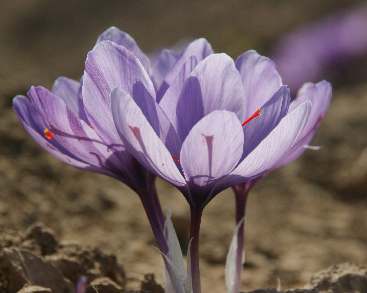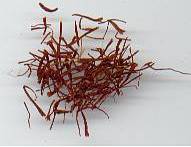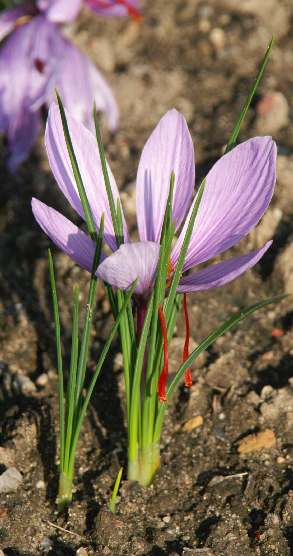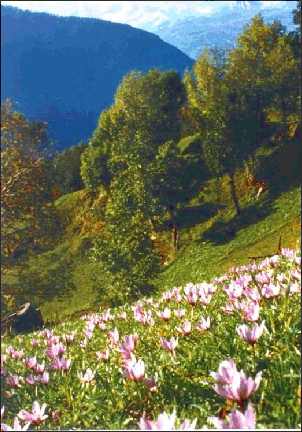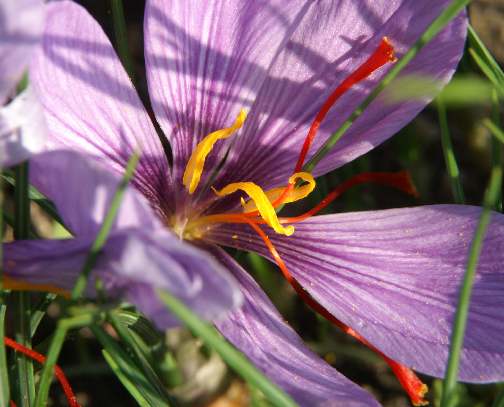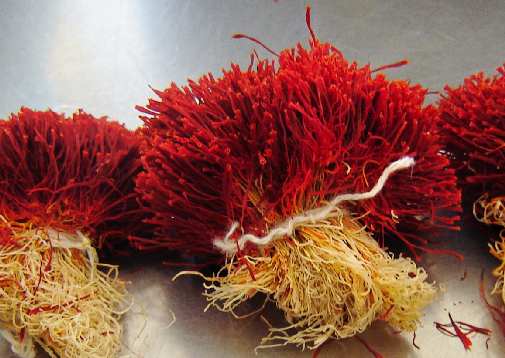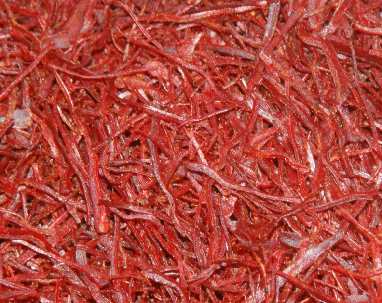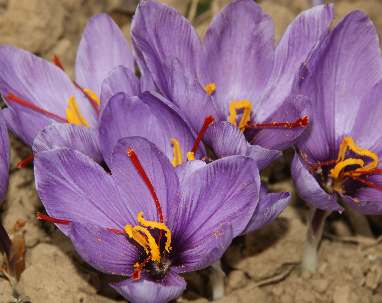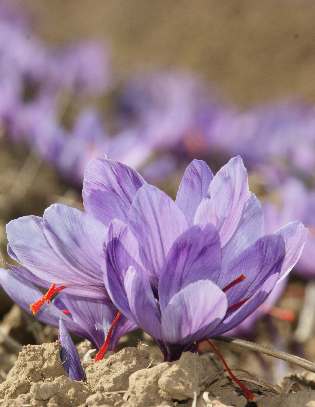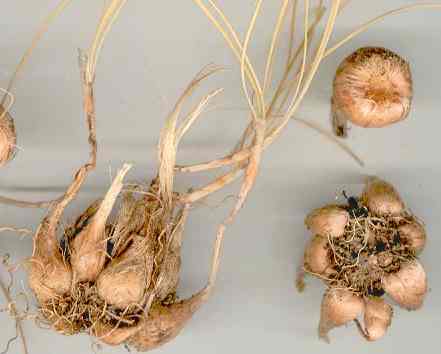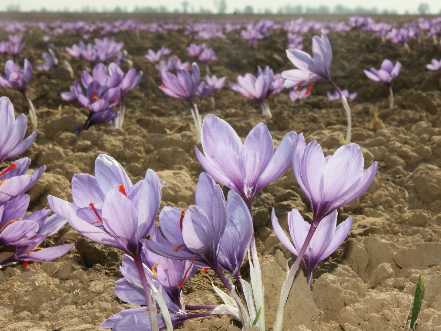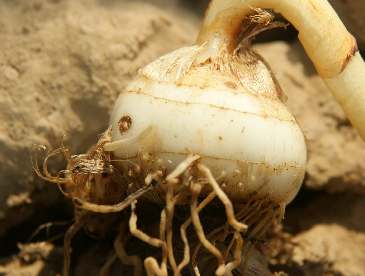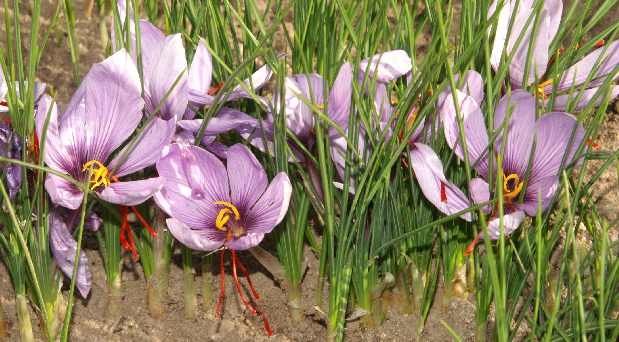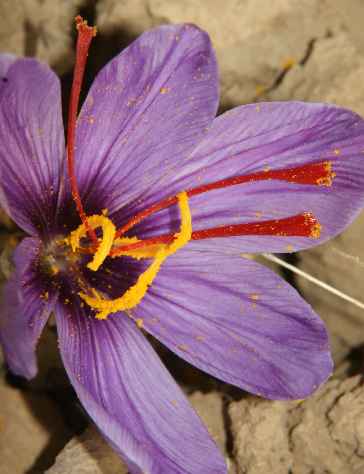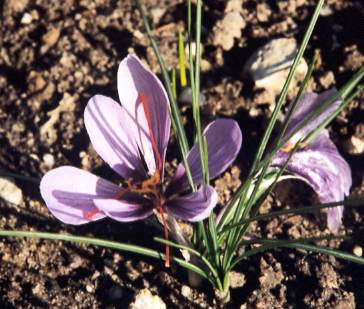| ||
|
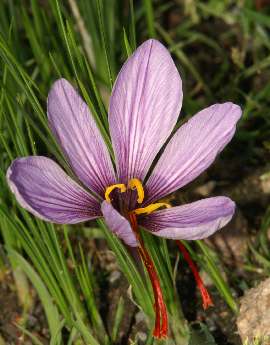
|
| Saffron flower |
probably smuggledto
probably not saffron at all). In production countries the price is, of course, much lower (one tenth), but so is the quality. Saffron’s aroma is unique and there is no substitute for it, but if unavailable, vanilla, kewra water, rose water or tonka beans are possible alternatives for saffron in sweets and cakes.
The statement Saffron is the most expensive spice in the world is without any doubt correct, looking at the price per gramm; on the other hand, saffron is also very intensive and therefore used in minute amounts: One gram of saffron goes a much longer way than the financially equivalent portion of most other spices. Half a teaspoon of saffron (which might well be a fifth of a gram) is, for example, enough for one liter of saffron custard, provided the saffron is of reasonable quality.
There are several other plants that can give a yellow or orange colour to the food; yet none of these has the hypnotic fragrance of true saffron. You can fool the eye, but not the taste buds. See annatto for more information on culinary plant dyes.
Speaking of other yellow plants: Saffron cheating is as old as saffron trade,
and will persist as long as saffron is traded. There is a multitude of
possibilities how to cheat: Crude methods include selling something that is not
saffron at all — artificially coloured grass flowers, safflower and calendula flowers being obvious
candidates (meat fibers have aso been reported). The common mislabelling of turmeric
as Indian saffron
also borders fraud (after all, there is saffron
production in India!). People unaware of the taste of good saffron may be
persuaded to buy an old or overdried product. Even large spice companies
sometimes sell products that, although deriving from the right plant, have no
or even a false aroma. Increasing the weight of saffron by coating the stigmata
with a non-volatile liquid (fixed oil or glycerol, which gives a sweet taste an
untrained customer might even regard as a sign of quality) is also very common.
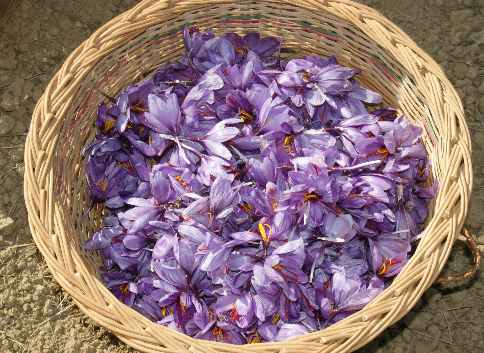
|
| A basket of saffron flowers |
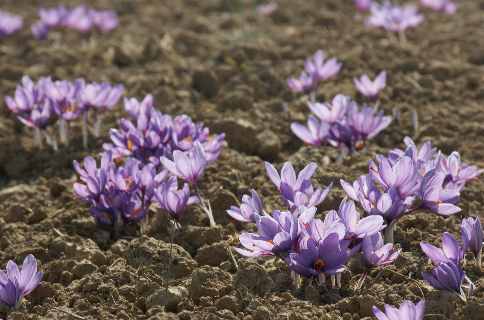
|
| Kashmiri saffron field (India) |
Buying saffron, thus, reduces to a matter of trust.
To ensure a reasonable quality, saffron should preferably be bought
whole, as any adulterants are very difficult to detect in ground saffron.
In a former version of this site, I had here the bold statement no self-respecting vendor sells ground saffron
,
but several vendors who considered themselves self-respecting protested. Indeed, saffron can retain its
aroma in ground state better than many herbs, if it is kept dry and cool. So there is nothing fundamentally
wrong with ground saffron, as long as it really is saffron (which will be difficult to prove without a lab).
Old European recipes sometimes prescribe astronomical amounts of saffron
(personally, I guess these saffron-rich spice mixtures have more the function
of a status symbol than that of a food additive), but in today’s Europe
saffron plays a minor rôle. It is, however, used for several
Mediterranean dishes, often in connection with fish and seafood: Famous
examples are the Italian risotto alla Milanese (moist
short-grain rice with bone marrow), the Provençal fish soup bouillabaisse (see also lavender)
and the Spanish national dish, paella Valenciana
(spicy dry short-grain rice with seafood or chicken); see also
sassafras for a
New-World-variant of paella. Furthermore, saffron appears
in a few European cake recipes, where it is used both for flavour and for
colour.
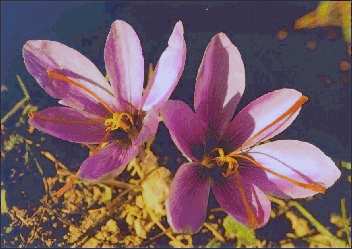
|
| Saffron flowers |
Saffron is more important in Central Asia and Northern India, where it is used extensively for rice dishes. Northern Indian biriyani [बिरयानी] is a fragrant and aromatic rice dishe, usually with chicken or mutton, which is intensively flavoured by saffron in conjunction with Indian bay leaves, cinnamon, cloves, green cardamom, star anise and nutmeg or mace; they are frequently decorated with nut or almond pieces and dried raisins or pomegranate seeds. The combination of saffron with peppermint in biriyanis of Persian style is especially delightful. Similar rice pots, in which saffron is combined with a hint of pungency, are found in the countries surrounding the Gulf of Arabia (majboos, see rose).
Indian sweets (kheer [खीर],
ras malai [रस मलाई])
are sometimes prepared with saffron; there is
a sweet saffron rice dish called zarda [ज़र्दा], which
is prepared by Indian Muslims at the end of the fasting month and
also enjoyed on other festive occasions. Saffron even sometimes
shows up in the famous Indian yoghurt drink lassi (see rose). Saffron-flavoured butter lassi
(makhaniya lassi [मक्खनिया लस्सी])
is an everlasting culinary impression for
everybody visiting Jodhpur, a great town in the center of Rajasthan.
Similarly, I will never forget the saffron-flavoured ice cream, which is
available chiefly in places where well-to-do domestic tourists spend their
holidays (see also vanilla).
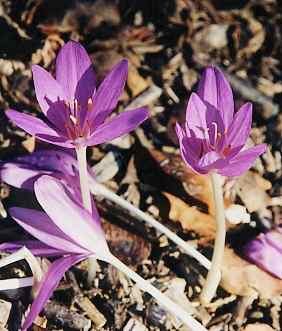
|
| Beware: This flower belongs to autumn crocus (Colchicum autumnale), a highly toxic plant common in Europe. |
Saffron is rather unique among spices in that its main aroma and colour components are water-soluble; therefore, the stigmata may be soaked overnight in water, filtered and the water then added, which gives a pure and homogeneous colour. Another method is preferred in Persia and India: The spice is powdered and then extracted with a little milk; after half an hour, the milk has the deep colour of egg yolk and is added to biriyanis or sweets. Using the dry spice (whether ground or as a whole) directly for cooking is not favourable, as it releases its fragrance too slowly, and prolonged cooking should be avoided for loss of aroma. Thus, it is best to prepare an extract with cold liquid and add that extract to the hot foods.
In high dosage, saffron exhibits toxic qualities. It has even been used as an abortificant in doses of five to ten gramms; such amounts, are, however already severely toxic. Due to its high price and the much smaller amounts used for cooking, accidental saffron poisoning seems to be very rare, though.
Although saffron can sometimes be found wild in Europe (more precisely,
escaped from former cultivation), it is not advisable for the botanically
unminded to collect wild saffron
: Chances are high that the plant
turns out to be the much more common autumn crocus, which is also
known as meadow saffron or naked ladies (Colchicum
autumnale). This plant is for good reason named after the ancient
country of poison brewing, Colchis [Κολχίς],
and is indeed one of the most dangerous plants in the European flora.
Interestingly, the leaves of autumn crocus can be confused with another edible
wild plant of Central Europe (bear’s garlic) and
have caused deaths repeatedly.
